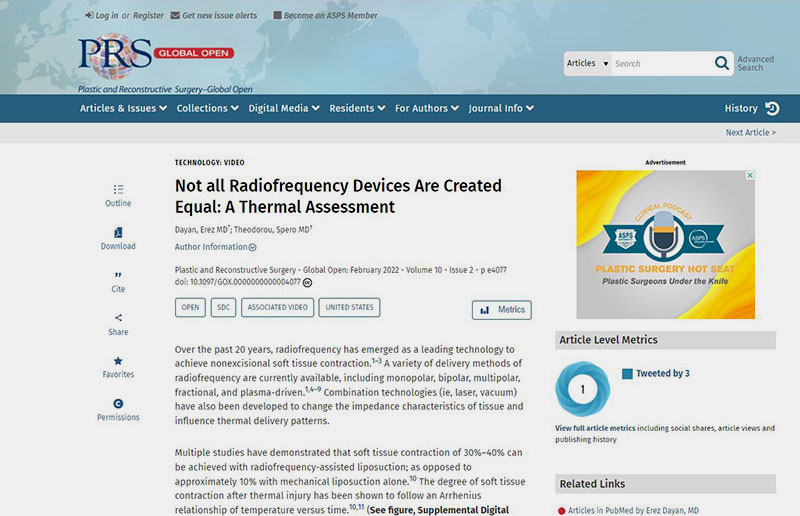A new study on radiofrequency devices, comparing the efficiency of different devices based on thermal assessment was published in the February 2022, Volume 10, Number 2 issue of Plastic and Reconstructive Surgery–Journal of the American Society of Plastic Surgeons. This informative article is authored by Erez Dayan MD and Spero Theodorou MD.

Radiofrequency is the leading technology used for effective non excisional soft-tissue contraction. There are various methods to deliver radiofrequency including monopolar, bipolar, multipolar, fractional and plasma-driven. Besides these methods, combination technologies are also being used to alter the impedance characteristics of the tissues for effective delivery of radiofrequency energy.
The authors compare the soft tissue contraction achieved by radiofrequency-assisted liposuction vs. that achieved by mechanical liposuction, based on multiple studies. Radiofrequency assisted liposuction achieves 30%-40% soft tissue contraction as opposed to 10% contraction with mechanical liposuction alone. Studies have shown that the extent of soft tissue contraction after thermal injury follows an Arrhenius relationship of temperature versus time. Higher temperature exposure for a shorter duration of time gives soft tissue contraction equivalent to that provided by exposure of the skin to lower temperature for a longer duration of time. This analysis is clinically beneficial to study various radiofrequency-assisted procedures and their outcomes.

Further, the article discusses plasma-driven radiofrequency devices (J-Plasma/Renuvion: Apex Medical) and bipolar radiofrequency devices (AccuTite, BodyTite, FaceTite: InMode), two radiofrequency delivery options that differ considerably in temperature vs. time philosophy.
Benefits of Plasma-driven Radiofrequency Delivery
- Plasma-driven radiofrequency became popularized when it received 510K FDA clearance for cutting, coagulation and soft-tissue ablation. The device uses helium gas plasma which is fueled by an electric current for treating tissues at higher temperatures for a longer duration of time.
- The current delivered is low, which results in minimal depth of thermal effect. This prevents overheating of tissues when performing multiple passes.
- As plasma-driven radiofrequency energy treats the tissues only for a short interval of time, the surrounding sites are undisturbed and remain at relatively cool temperatures.
- The volume of un-ionized helium gas in the cooling space ensures that there is no prolonged heating.
- The electric-current travels 360 degrees in an unfocused from the applicator tip. It will preferentially travel through tissues with the least resistance. This considerably reduces overheating of the tissues.
- The advantage of plasma-driven radiofrequency treatment is that epidermal burn risk is low. Surface temperatures rarely exceed 38 °C during the treatment.
Disadvantages of Plasma-driven Radiofrequency Delivery
- The low current is unable to penetrate high-impedance tissues, and this results in minimal depth of effect.
- If the radiofrequency is applied nearby previously treated tissue, the energy traverses the path of least resistance or lower impedance.
The study suggests that high impedance structures like adipose tissues and fibroseptal networks should be treated for optimal soft tissue contraction.
Benefits of Bipolar Radiofrequency Delivery
- There is controlled directionality of radiofrequency that distributes thermal energy across tissues with higher impedance like adipose tissue, fibroseptal networks and reticular dermis.
- The volumetric heating is more gradual compared to plasma-driven radiofrequency. So, it maintains a wide heat signature for a longer time, up to 60 minutes, after the treatment.
- The device has an external temperature probe to ensure that there is added layer of safety by maintaining the temperature at 38-40 degree Celsius.
Data comparing the clinical outcomes of diverse radiofrequency delivery devices is limited. The authors opine that volumetric heating in a bipolar direction is more advantageous for obtaining optimum soft tissue contraction results. Extended and evenly distributed heating at the skin surface using InMode’s BodyTite/FaceTite bipolar radiofrequency devices works to maintain thermal injury and contract the target tissues. On the other hand, quick heating at high temperatures is associated with quick cooling, loss of contractile effect, and collagen recoil. As experienced plastic surgeons know, newer generation devices with internal / external temperature probes and impedance monitors can reduce the safety concerns associated with bipolar radiofrequency volumetric heating. Radiofrequency is proven to be a safe and effective, non-invasive alternative for soft tissue contraction. The authors conclude that more data is vital to clarify the differences between diverse radiofrequency technologies for optimum safety and effectiveness.
Click on the link below to download the PDF.
Not all Radiofrequency Devices are Created Equal: A Thermal Assessment
Erez Dayan, MD, Spero Theodorou, M.D. PRS Global Open, February 2022
